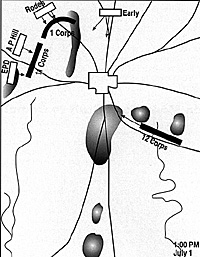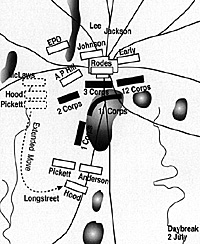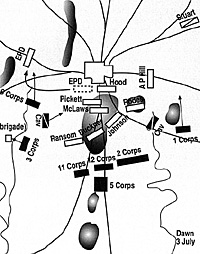 Many a Civil War buff has pondered these questions: "What if Stonewall Jackson had recovered from his wound at Chancellorsville? Would Lee still have switched to a three corps alignment? Would the CSA still possess those intangibles of aggressiveness and invincibility? How would a two corps approach have fared for the gray and butternut at Gettysburg?"
Many a Civil War buff has pondered these questions: "What if Stonewall Jackson had recovered from his wound at Chancellorsville? Would Lee still have switched to a three corps alignment? Would the CSA still possess those intangibles of aggressiveness and invincibility? How would a two corps approach have fared for the gray and butternut at Gettysburg?"
These are all questions without answers. The neat thing about the hobby of conflict simulation is that one can attempt to explore answers to hypothetical questions in a realistic vehicle. The vehicle that we chose to drive was our favorite gaming system, the Deac chose to play the Union. He added French's Division at a cost of three victory points (plus he knows that I like to attack early on the second day with the CSA).
I played the Rebs using the "Jackson Lives!" special rules (Scenario 11). We both wanted to see how responsive the CSA is using a two-corps structure. This option comes at a cost of five
victory points. In addition, I chose to add Ransom's Division to 1 Corps at a cost of two victory points and Buckner' Division at a cost of th ree victory points.
Ed. note: See game rules 4.3d and 4.3h
This also enabled me to get Law's Brigade and Pickett's Division at midnight on 2 July instead of later in the day.
Deac and I game CWB against each other about 20 hours a month. We have gamed Thunder at the Crossroads many times and are familiar with each other's strategies, tactics, thinking,
and nuances.
Deac roughly broke his strategy for the game into days. On the first day, he planned to defend as far forward as possible from Gettysburg and conduct a fighting withdrawal when pushed. He hoped to roll 12 Corps into the battle at an early time to bolster his
right. (We always play with the random reinforcement die rolls.)
His goal at the end of the first day was to control the hills and
limit my axis of advance for an early morning attack on the second.
As the second day ended, he anticipated going over to the attack
with 5 and 6 Corps to nail down a big victory.
I planned to carry the impetus of attack to Deac, although
not in a reckless and headlong manner as I have seen many CSA
players do in Thunder. Jackson's 2 Corps would carry the attack
on the first day. I had three goals: inflict as many casualties as
possible on the cavalry, 1 Corps and 11 Corp. capture Gettysburg;
and either capture the hills or open up opportunities for an extended march by the three divisions of 1 Corps that I expected to have on map by 2:00AM.
If all worked as planned, I would have possession of
Cemetery Hill, Culp's Hill, and Little Round Top by 1:00 pm. on
the second day. Then, we would batten down the hatches and hope
Deac would wreck his corps on our defensive positions to garner
that elusive victory on Northern soil that Marse Robert so
desperately sought.
Combat starts with Ewell's Provisional Division (EPD)
engaging the Union cavalry at a two-hex range; part of my early day
strategy is to maintain pressure on Gamble in the hopes of wrecking
them for victory point purposes and maneuvering onto a flank to
prepare for the arrival of A. P. Hill. Hill is tardy (he does not arrive
until 11:30!) and the Union 1 Corps is now deployed on the ridge
line with 11 Corps moving up to support on its left.
Things are not going as planned for the South. Ewell and Hill
concentrate on 11 Corps in the hopes that Stonewall will arrive on
the left later in the day. Fierce fighting takes place around
McPherson's Wood and Ridge as the two sides trade volleys at 200
yards. By 1:00, Deac has 11 Corps Up and is deployed on Reynolds' left.
At this time, the Stonewall mystique comes into play.
Over the next two turns, I would roll consecutive tens to
bring on Rodes, Early, and Stonewall himself to form a perfectly
echeloned flank attack on 1 Corps.
In two turns, Reynolds' men begin to stream off Oak Hill
and back toward Gettysburg; it is only the heroic stand of the
Iron Brigade and Cutler's men that prevents a Union rout. Just
as I think that the day will be mine, Deac rolls on 12 Corps and
directs them to take blocking positions in front of Gettysburg. By now Johnson is up and Longstreet is assembling 1 Corps to continue the drive on the Union left.
One of the problems we discovered with a two-corps
alignment was limited corps frontage. Hill and Ewell had to sidle
continually to their left to get in command radius, recover
stragglers, shift units in and out of combat, and generally stay in
the fight. I had not planned to commit Anderson on the first day; I
wanted to use him as part of a 1 Corps hammer blow on day two.
However, at 5:30PM he went into line on the far right to
flank 11 Corps. By 6:00PM, Union resistance had broken as they
streamed back towards Cemetery Hill. Not wanting to charge a gun
line with weakened units, Stonewall called it quits for the day.
It was a brutal first day. CSA casualties were at the
13,000 mark while the Bluebellies pushed 12,000. Dick Ewell took
a minie-ball in the head, both Union cavalry brigades were
wrecked, and the South held Gettysburg. However, Deac still held
the big victory point areasÄthe hills.
From there, they would attack up the ridge to clear it. If
Hood showed up, he would receive a divisional goal to secure
Little Round Top and cut off an avenue of escape. Johnson would
receive a divisional goal to conduct an extended march around the
Union right, secure the bridge, and attack into the Union rear. Later,
Jackson would support the attack in the center.
Deac's strategy called for a dawn attack with 3 and 12 Corps
into Gettysburg and a probe by Hancock's men into Longstreet's
staging area. These also occurred using extended movement.
Perhaps we unrealistically use extended movement in our
gamesÄwe often boldly go at night off roads where most 19th
century armies refused to go. At times we operate as if we have
LANDSAT circling overhead. Ideas on this aspect of CWB are
welcome but do not ask us not to use extended movement. It is one
of the few gaming vehicles that simulates fog of war and limited
intelligence.
At daybreak, little did we know that one of the most
interesting gaming sessions either one of us has ever had would await
us over the next ten hours. Because I failed to screen Longstreet's
march adequately, Hancock's probe pops his extended movement;
instead of 36 big movement points crashing down on 1 Corps, I have
only 18.
However, it is enough to position Pickett and Anderson on
the Union far left and on Cemetery Ridge. Deac sees the trap and
gets initiative with Hancock to fall back to the Union left, but he
cannot call back Sickles and Slocum as they crash down Cemetery
Hill into Rodes, Early, and A. P. Hill. The attack disintegrates in
two turns as Stonewall made four different 66 morale rolls on Deac.
By 6:30, Deac knows the danger is real and imminent. Hood and McLaws are marching to join Longstreet while Pickett launches a furious attack into Reynolds. Johnson comes out of his extended march three hexes from the bridgeÄjust in time to see Devin's Brigade block passage. Deac is now trying to extract the Union army from a potential disaster; he does an ECR with 3, 11 and 12 Corps. However, he gets initiative with Hancock and Reynolds to hold open the escape route back toward Little Round Top. Jackson's attack orders kick in at 6:30 and 2 D Corps begins
measured pressure on the Union center. If only Johnson can clear the bridge and Hood's order to secure the Round Tops can gain acceptance, I can put Deac in a very bad position.
However, they do not. Falaise Pocket II ends with Deac
getting the Army of the Potomac out of danger and setting up a line
along the Round Tops. By 11:00 AM, I had the hills and had
damaged three Union corps to the point where we both knew they
could not conduct offensive operations the rest of the battle (1, 11
and 12). I had severely damaged his cavalry arm but had let a great
opportunity escape.
Both sides spent the rest of the day maneuvering. Deac
aimed to establish a strong defensive line bolstered by the Reserve
artillery and I tried to match Longstreet up against a damaged Union
corps.
Casualties at the end of the second day were 16,100 for the
CSA and 15,600 for the USA. For the CSA, Longstreet still had
offensive capability while Jackson did not. For the USA, 1, 2, 11 and
12 Corps did not possess attack strength but, 3, 5, 6 and the new
cavalry units did.
The two corps also encouraged the writing of divisional
goals, especially on the attack. This can be good and bad. The good
is it increases flanking opportunities; the bad is that the attacks do
not have much staying power.
My strategy for the third day is simple; put Stonewall and a
reinforced 2 Corps with Buckner on the hills, screen my flanks with
cavalry and detached units, and place Longstreet into reserve behind
Cemetery Hill to act as a counterattack force if Deac pushes the
issue. I am content for my draw or minor victory.
Deac opts for a bolder strategy. He conducts an extended
march onto my right (made possible because EPD was seven turns
tardy in reacting to a screening order) with 6 Corps, 3 Corps and
Pleasonton's command. I am not sure if his plan is to go for the
victory point entry areas or turn for Gettysburg. At the same time,
he brings measured pressure to bear on my center and left with his
guns and other corps.
Wilcox and detached guns stop 3 Corps' attack across the
bridge. However, 6 Corps and the screening cavalry find success
southwest of Gettysburg. Ewell is the only division in their way. 6
Corps succeeds in driving Ewell towards McPherson's Ridge. At the
same time, another of Deac's extended movements appearsÄ1
Corps reinforced with French appears near Benner's Hill! (jumbling
that 1 Corps is a diversion and A. P. Hill, though badly damaged
from the first day's fight, can deal with the threat, Lee orders
Longstreet to counterattack against 6 Corps to clear the entry point
areas. Brutal fighting ensues as Pickett, Hood, and McLaws throw
their divisions into the breach. Deac is able to change Sickle's orders
(no mean feat) so that 3 Corps is now following 6 Corps into the
breach. Lee detaches Ransom to add to the carnage.
Then the fickle finger of fate intervenes. Sickles blows a
Corps Attack Stoppage roll. To keep the attack rolling, Deac
gambles on initiativeÄsnake eyes!! Sickles decides that he likes it
better at Little Round Top! Couple this with JEB Stuart's
immediate acceptance for a long flanking ride left of 6 Corps, and
Korsun Pocket II was in progress.
Deac sends 5 Corps into the mess to save Pleasonton and
Sykes. The fighting goes on in see-saw fashion until 10:30 when
Deac calls off the dogs of war. Both armies are too spent for further
offensive action; we call it a game after 60 hours of wild, enjoyable
gaming!
According to the victory point table, it was a draw.
Casualties were 23,400 for the CSA and 22,400 for the USA.
Longstreet was wrecked as was Union 3 Corps, 6 Corps and four
cavalry brigades. The Confederates stayed on the field and possibly
gained a moral victory on Northern soil but the cost of the variants
cost me any shot at victory. Both sides suffered huge losses, which
the North could obviously replace more easily. I am sure the leadership of both sides would have some explaining to do about lost opportunities.
Thunder is a great game. Yet, next time I play the CSA, I
will insist on getting Lee and company on their upsides with no
victory point penalty. It is a tough row to hoe without them on
their good sides, yet it makes it tough to win when giving up five
victory points. We have never played using the D.H. Hill
optionÄhow about the rest of you? Granted, 60 hours was a lot
of time to spend, but what else did we have to do in January,
February, March and April in Ohio?
Union Strategy
Confederate
Strategy
The First
Day
The Second
Day
 The burden of attack was still on me as a council of war
occurred at Lee's headquarters. Pickett and Johnson were up, but no
word from Hood. The council decided to try a bold flanking
extended march to trap the Union army on the hills. Longstreet
would take the available portions of 1 Corps and follow the tree
and creek line onto Cemetery Ridge.
The burden of attack was still on me as a council of war
occurred at Lee's headquarters. Pickett and Johnson were up, but no
word from Hood. The council decided to try a bold flanking
extended march to trap the Union army on the hills. Longstreet
would take the available portions of 1 Corps and follow the tree
and creek line onto Cemetery Ridge.
The Third Day
 So far, we had invested about 45 hours in gaming Stonewall
Lives! It had been very profitable and interesting to this point.
Some of the observations that we made of the CSA two-corps
structure were that Lee had less flexibility with two corps
compared to three, but two corps hit harder on the attack partly
due to limited frontage of the corps. Also, it was a more responsive
command set up as there were fewer orders to write.
So far, we had invested about 45 hours in gaming Stonewall
Lives! It had been very profitable and interesting to this point.
Some of the observations that we made of the CSA two-corps
structure were that Lee had less flexibility with two corps
compared to three, but two corps hit harder on the attack partly
due to limited frontage of the corps. Also, it was a more responsive
command set up as there were fewer orders to write.
So, Who
Won?
Afterthoughts
Back to Table of Contents -- Operations #24
Back to Operations List of Issues
Back to MagWeb Master List of Magazines
© Copyright 1997 by The Gamers.
This article appears in MagWeb (Magazine Web) on the Internet World Wide Web.
Other military history articles and gaming articles are available at http://www.magweb.com